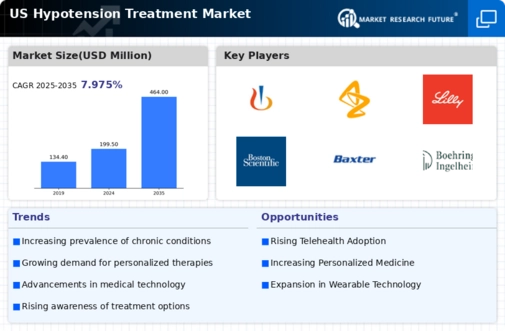Increased Healthcare Expenditure
Rising healthcare expenditure in the United States is positively affecting the hypotension treatment market. As healthcare budgets expand, there is a greater allocation of resources towards the diagnosis and treatment of various health conditions, including hypotension. This trend is likely to facilitate access to advanced treatment options and improve patient outcomes. According to recent statistics, healthcare spending in the U.S. is projected to reach $6 trillion by 2027, which may enhance the availability of treatments and services in the hypotension treatment market.
Advancements in Medical Technology
Technological advancements in medical devices and treatment methodologies are significantly influencing the hypotension treatment market. Innovations such as wearable blood pressure monitors and automated diagnostic tools enhance the ability to detect and manage hypotension effectively. The integration of artificial intelligence in monitoring systems allows for real-time data analysis, which can lead to timely interventions. The market for medical devices is projected to grow at a CAGR of around 6% over the next few years, indicating a robust demand for advanced solutions in the hypotension treatment market.
Growing Awareness of Hypotension Risks
The increasing awareness of the health risks associated with hypotension is driving the hypotension treatment market. Educational campaigns by healthcare organizations emphasize the importance of recognizing symptoms and seeking treatment. This heightened awareness is likely to lead to more individuals being diagnosed and treated for hypotension. According to recent data, approximately 5-10% of the population experiences some form of hypotension, which suggests a substantial market potential. As more patients seek medical advice, the demand for effective treatment options is expected to rise, thereby propelling the growth of the hypotension treatment market.
Aging Population and Increased Incidence
The aging population in the United States is contributing to the rising incidence of hypotension, thereby impacting the hypotension treatment market. Older adults are more susceptible to various health conditions, including cardiovascular diseases, which can lead to hypotension. As the demographic of individuals aged 65 and older continues to expand, the prevalence of hypotension is expected to increase. This demographic shift suggests a growing need for effective treatment options, which could drive market growth. It is estimated that by 2030, nearly 20% of the U.S. population will be over 65, further emphasizing the potential for the hypotension treatment market.
Regulatory Support for Innovative Therapies
Regulatory bodies in the United States are increasingly supportive of innovative therapies for managing hypotension, which is likely to influence the hypotension treatment market. Initiatives aimed at expediting the approval process for new medications and treatment modalities can lead to a faster introduction of effective solutions. This regulatory environment encourages pharmaceutical companies to invest in research and development, potentially resulting in a wider array of treatment options for patients. The approval of new therapies could significantly enhance the competitiveness and growth of the hypotension treatment market.























Leave a Comment